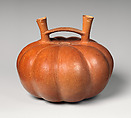Gourd-shaped bottle
The animals commonly represented in ancient Andean art are wild, while the plants are usually cultivated, such as corn, potatoes, yucca, and squash, all staples in much of the South American Precolumbian world. This elegant southern Peruvian vessel in the shape of a gourd was made at a time when significant advances in ceramic technology were taking place. Unlike the earlier thick-walled, dark brown ceramics decorated with postfired resin paint produced in the area, this double-spout-and-bridge bottle has very thin walls and a bright orange-red color. To achieve this color, its surface was covered with a slip (a watery clay suspension) before firing in an oxidizing atmosphere. Vessels of this type are called Topará for the coastal site north of the Chincha Valley. Topará vessels are coeval with late Paracas and early Nazca ceramics and have been found in burials on the Paracas Peninsula.
Due to rights restrictions, this image cannot be enlarged, viewed at full screen, or downloaded.

